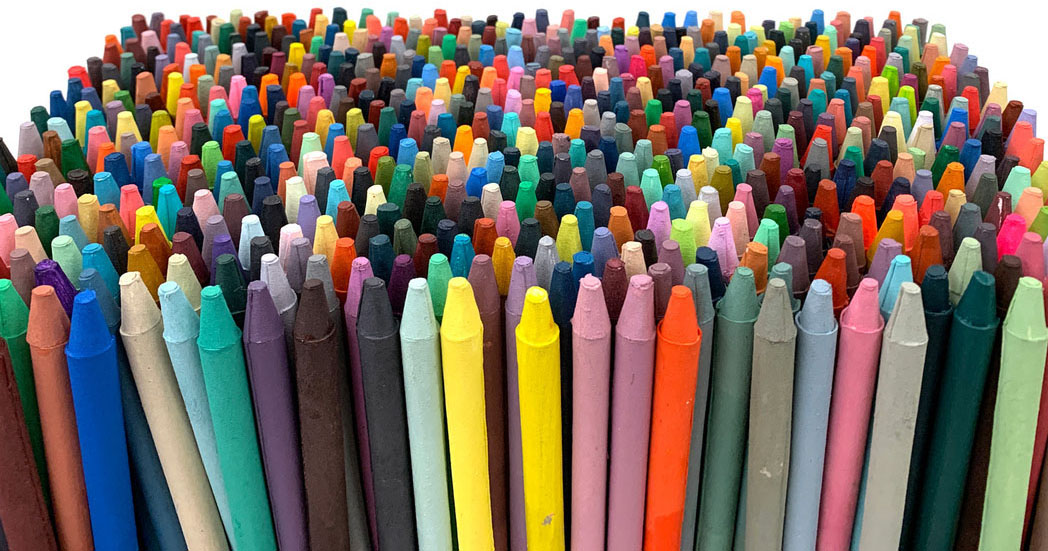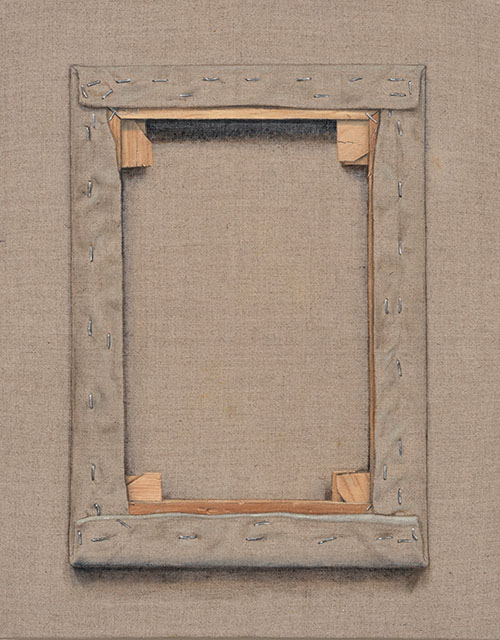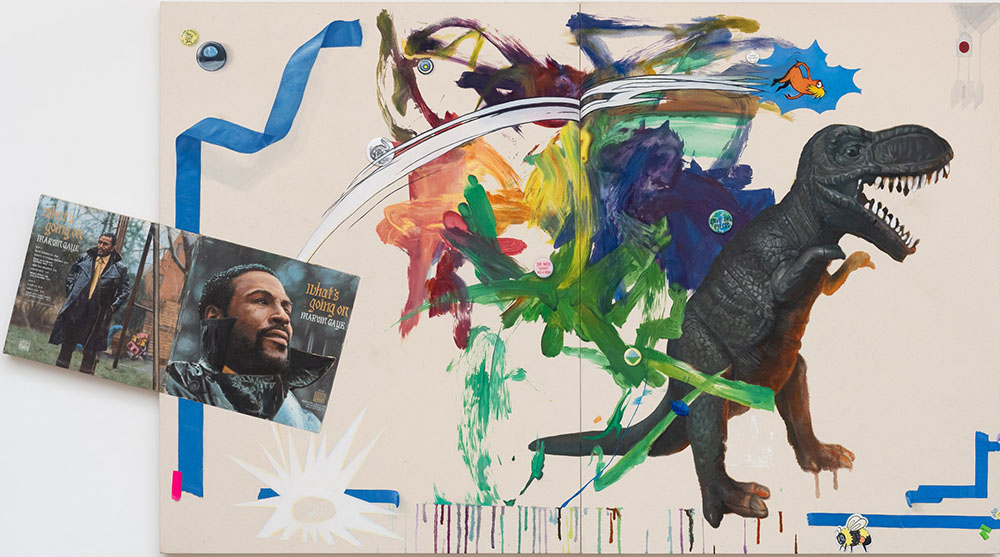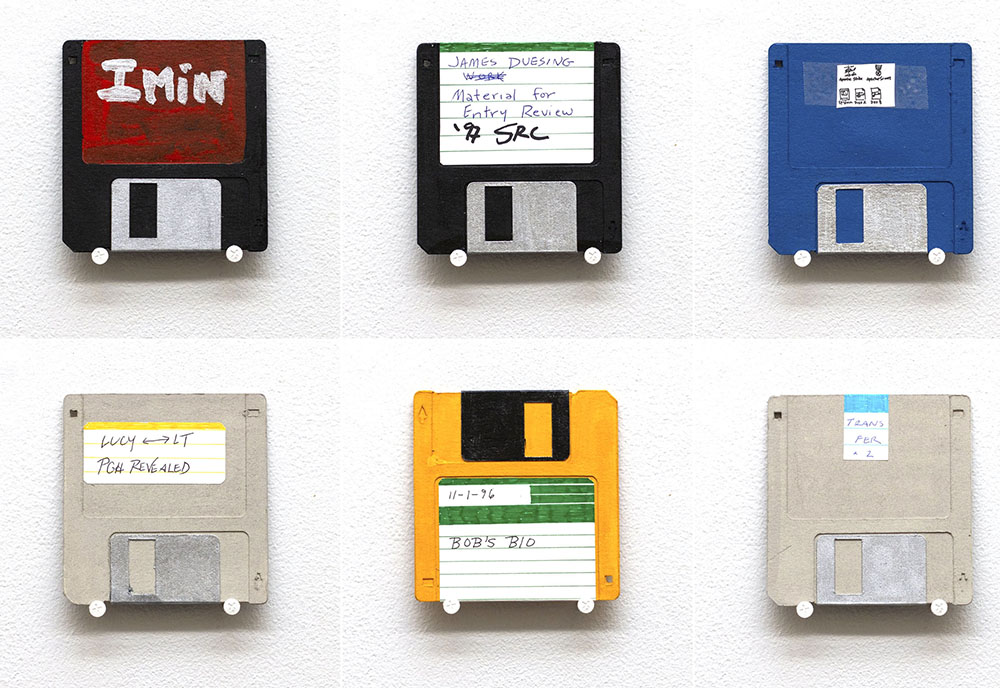by Renny Pritikin

On the floor near the entrance to the Catharine Clark Gallery, dozens of multicolored crayons line up below a bank of low-hanging flood lights. Look closely and you see that there are no crayons or lights. It’s a trompe l’oeil installation of paper objects by Imin Yeh, titled A Salty Rainbow. Yeh’s work is juxtaposed with that of Michael Hall in a companionable pair solo exhibitions. Hall also loves to trick the eye. In his tour-de-force of illusionism, Face to Face, the back of a framed painting on linen is reproduced on an identical stretched linen canvas worthy of the great 19th-century illusionist William Harnett.

While illusion is central to the work of both artists, it is not their sole subject. Both mine their own lives for material. Yeh’s School Clock, made of paper, is “set” to the time her daughter was born. It’s identical to a real clock Lenka Clayton installed in the same spot last year. Yeh’s, however, isn’t just playing with visual puns (real clock/paper clock), but with our understanding of time, conflating the time she gave birth, the time of Clayton’s show, the time of her own show, and our visit to the gallery. Hall does something similar the title piece of his exhibition, For Real Life, a painting in which he hyper-realistically recreates the door of his five-year-old son’s bedroom, covering it with paintings that replicate posters, notes and stickers on the actual door, along with paintings glued onto the canvas “portal.” The metaphor of a door standing between father and son is powerful, as is the reality that a closed door can always be opened.
Born into a military family in San Diego, Hall earned an MFA from Mills College, where he became close to Hung Liu. Go Paint (for Hung), a haunting tribute, is an exact painted replica of her last palette, accompanied by a jar of dandelions on a shelf, a plant they both enjoyed depicting. It (and other paintings) also contain a QR code. Point your phone camera at it, and you’re led to explanations of his ideas, one of which is that painting need not be a fixed site, but rather a nexus for investigations into the history and cultural meaning of the books, images and objects he depicts.
One of Hall’s pieces, Walking In Your Footsteps, shows a swirling tornado sharing space with a carefully rendered, greatly enlarged toy dinosaur and the cover of Marvin Gaye’s 1971 political album, What’s Going On. The vibrant colors are an enlarged reproduction of his son’s efforts, while the dinosaur serves as a metaphor for the world’s oil dependence. All three elements combine to create a powerful cri de coeur about pressing issues like ecology and parenthood. Homages to other artists feature in Hall’s work. Neither Either Or, an exquisite recapitulation of the famous Richter candle painting, Kerze I, also references the Sonic Youth album cover featuring the same image – a labyrinth of references within references.

Hall’s graphite drawings show his mastery of the medium. The most notable are (again) those inspired by his son. Sycamore Leaves depicts a bouquet of dead leaves he gathered. Farewell Grover shows the neck of a guitar his son broke, while Mood, a sparse image, represents a collection of burned wooden matches. Each exhibits a dark undercurrent, a meditation on loss and mortality.
Imin Yeh, a Pittsburgh, Pa.-based artist who grew up in Bethesda, Md. and received her MFA from CCA, offers an ambitious piece titled Floppy Copy, a grid of 85 floppy discs recreated in paper and mounted on a wall: a self-portrait built from recreations of discarded things. Like Hall, Yeh is inspired by her young daughter’s life, evidenced in pieces like A Perfect Stack, screen prints on paper made to look like wooden blocks piled almost up to the ceiling, and Goodnight Moon, a tri-part (screen print) homage to the beloved children’s book.

Yeh’s show is dominated by two dozen tiny trompe l’oeil paper objects (e.g., rubber bands, foodstuffs, flowers, paper rolls, an eraser, bandages) dispersed around the gallery, each pinned to the wall with binder clips made of paper. The precision, wit and imagination demonstrated by these phantasms are remarkable. dreamcabin, developed out of the isolation of the pandemic, engages a similar dynamic.
She built a tabletop chalet and asked dozens of artist friends to fill it with tiny furniture and decorations. There’s a can’t-look-away allure to it, perhaps because we can’t resist seeing our world reduced to the scale of doll houses or dioramas, the most notable example being the Thorne Miniature Rooms at the Art Institute of Chicago.
Finally, a warning: Think twice before dropping trash into the plastic-lined wastepaper baskets stationed around the gallery. They test how closely you’ve been paying attention to the exhibition.
# # #
Michael Hall: “For Real Life” and Imin Yeh: “A Salty Rainbow” @ Catharine Clark Gallery through July 6, 2024.
About the author: Renny Pritikin was the chief curator at The Contemporary Jewish Museum in San Francisco from 2014 to 2018. Before that, he was the director of the Richard Nelson Gallery at UC Davis and the founding chief curator at Yerba Buena Center for the Arts beginning in 1992. For 11 years, he was also a senior adjunct professor at California College of the Arts, where he taught in the graduate program in Curatorial Practice. Pritikin has given lecture tours in museums in Japan as a guest of the State Department, in New Zealand as a Fulbright Scholar, and visited Israel as a Koret Israel Prize winner. The Prelinger Library published his most recent book of poems, Westerns and Dramas, in 2020. He is the United States correspondent for Umbigo magazine in Lisbon, Portugal and the author of a recently published memoir, At Third and Mission: A Life Among Artists.
While impressive, this work is very reminiscent of Daniel Douke”s work from the 1970’s and 80’s. I was always impressed and inspired by his trompe l’oeil paintings of utilitarian, everyday objects.
Come see it and you’ll uncover the nods to the history of trompe l’oeil through new eyes, approaches, politics, and practices. There are so many wonderful artists who have worked and are working in this genre, each bringing something fresh to the aesthetic and conceptual discussion on illusion-based work.
I have always had an interest in illusion-based work and appreciate your comments. It is refreshing to see the continuation of this conversation in these dynamic works. I find it apropos of the times we are living in, trying to decipher what is real versus what is illusion. Thank you so much!